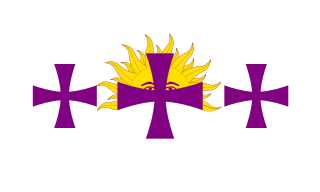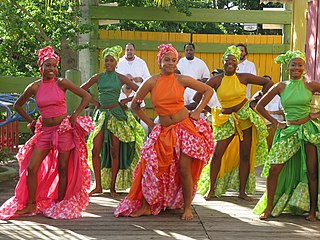The masculine term Latino, along with its feminine form Latina, is a noun and adjective, often used in English, Spanish, and Portuguese, that most commonly refers to United States inhabitants who have cultural ties to Latin America.

The population of Puerto Rico has been shaped by native American settlement, European colonization especially under the Spanish Empire, slavery and economic migration. Demographic features of the population of Puerto Rico include population density, ethnicity, education of the populace, health of the populace, economic status, religious affiliations and other aspects of the population.

The term Hispanic refers to people, cultures, or countries related to Spain, the Spanish language, or Hispanidad broadly. In some contexts, especially within the United States, "Hispanic" is used as an ethnic or meta-ethnic term.

Puerto Ricans, most commonly known as Boricuas, and also referred to as Borinqueños,Borincanos, or Puertorros, are the people of Puerto Rico, the inhabitants and citizens of the Commonwealth of Puerto Rico and their descendants, including those in mainland United States.
Mulatto is a racial classification to refer to people of mixed African and European ancestry. Its use is considered outdated and offensive in several languages, including English and Dutch, but it does not have the same associations in languages such as Italian, Spanish and Portuguese. Among Latin Americans in the US, for instance, the term can be a source of pride. A mulatta is a female mulatto.
In the United States census, the U.S. Census Bureau and the Office of Management and Budget define a set of self-identified categories of race and ethnicity chosen by residents, with which they most closely identify. Residents can indicate their origins alongside their race, and are asked specifically whether they are of Hispanic or Latino origin in a separate question.
Afro–Latin Americans or Black Latin Americans are Latin Americans of full or mainly sub-Saharan African ancestry.
Piri Thomas was a Puerto Rican-Cuban writer and poet whose memoir Down These Mean Streets became a best-seller.

Hispanic and Latino Americans are Americans of Spanish and/or Latin American background, culture, or family origin. These demographics include all Americans who identify as Hispanic or Latino regardless of race or ancestry. As of 2020, the Census Bureau estimated that there were almost 65.3 million Hispanics and Latinos living in the United States and its territories.

The United States has a racially and ethnically diverse population. At the federal level, race and ethnicity have been categorized separately. The most recent United States census recognized five racial categories, as well as people who belong to two or more of the racial categories. The United States also recognizes the broader notion of ethnicity. The 2000 census and 2010 American Community Survey inquired about the "ancestry" of residents, while the 2020 census allowed people to enter their "origins". The Census Bureau also classified respondents as either Hispanic or Latino, identifying as an ethnicity, which comprises the minority group in the nation.
Afro-Dominicans are Dominicans of predominant or full Black African ancestry. Approximately 7.9 million people in the Dominican Republic are of African descent, However due to the Dictatorship of Rafael Trujillo, those who do identify as black are a minority in the country representing 7.8% of the population, according to a census bureau survey in 2022. About 4.0% of the people surveyed claim an Afro-Caribbean immigrant background, while only 0.2% acknowledged Haitian descent. Currently there are many black illegal immigrants from Haiti, who are not included within the Afro-Dominican demographics as they are not legal citizens of the nation.

Dominican Americans are Americans who trace their ancestry to the Dominican Republic. The phrase may refer to someone born in the United States of Dominican descent or to someone who has migrated to the United States from the Dominican Republic. As of 2021, there were approximately 2.4 million people of Dominican descent in the United States, including both native and foreign-born. They are the second largest Hispanic group in the Northeastern region of the United States after Puerto Ricans, and the fifth-largest Hispanic/Latino group nationwide.

Afro–Puerto Ricans are Puerto Ricans who are of African descent. The history of Puerto Ricans of African descent begins with free African men, known as libertos, who accompanied the Spanish Conquistadors in the invasion of the island. The Spaniards enslaved the Taínos, many of whom died as a result of new infectious diseases and the Spaniards' oppressive colonization efforts. Spain's royal government needed laborers and began to rely on African slavery to staff their mining and fort-building operations. The Crown authorized importing enslaved West Africans. As a result, the majority of the African peoples who entered Puerto Rico were the result of the Atlantic slave trade, and came from many different cultures and peoples of the African continent.

At the 2010 census, there were 1,526,006 people, 590,071 households, and 352,272 families residing in the consolidated city-county of Philadelphia, Pennsylvania. The population density was 4,337.3/km2 (11,233.6/mi2). There were 661,958 housing units at an average density of 1,891.9/km2 (4,900.1/mi2).
White Hispanic and Latino Americans, also called Euro-Hispanics, Euro-Latinos, White Hispanics, or White Latinos, are Americans of white ancestry and ancestry from Latin America. It also refers to people of European ancestry from Latin America that speak Spanish natively and immigrated to the United States.
Racism in Cuba refers to racial discrimination in Cuba. In Cuba, dark skinned Afro-Cubans are the only group on the island referred to as black while lighter skinned, mixed race, Afro-Cuban mulattos are often not characterized as fully black or fully white. Race conceptions in Cuba are unique because of its long history of racial mixing and appeals to a "raceless" society. The Cuban census reports that 65% of the population is white while foreign figures report an estimate of the number of whites at anywhere from 40 to 45 percent. This is likely due to the self-identifying mulattos who are sometimes designated officially as white. A common myth in Cuba is that every Cuban has at least some African ancestry, influenced by historical mestizaje nationalism. Given the high number of immigrants from Europe in the 20th century, this is far from true. Several pivotal events have impacted race relations on the island. Using the historic race-blind nationalism first established around the time of independence, Cuba has navigated the abolition of slavery, the suppression of black clubs and political parties, the revolution and its aftermath, and the special period.
Hispanic and Latino are ethnonyms used to refer collectively to the inhabitants of the United States who are of Spanish or Latin American ancestry. While the terms are sometimes used interchangeably, for example, by the United States Census Bureau, Hispanic includes people with ancestry from Spain and Latin American Spanish-speaking countries, while Latino includes people from Latin American countries that were formerly colonized by Spain and Portugal.
Historically, Puerto Rico, which is now an unincorporated territory of the U.S., has been dominated by a settler society of religiously and ethnically diverse Europeans, primarily of Spanish descent, and Sub-Saharan Africans. The majority of Puerto Ricans are multi-ethnic, including people of European, African, Asian, Native American, and of mixed-ethnic descent.

Blanqueamiento in Spanish, or branqueamento in Portuguese, is a social, political, and economic practice used in many post-colonial countries in the Americas and Oceania to "improve the race" towards a supposed ideal of whiteness. The term blanqueamiento is rooted in Latin America and is used more or less synonymously with racial whitening. However, blanqueamiento can be considered in both the symbolic and biological sense. Symbolically, blanqueamiento represents an ideology that emerged from legacies of European colonialism, described by Anibal Quijano's theory of coloniality of power, which caters to white dominance in social hierarchies. Biologically, blanqueamiento is the process of whitening by marrying a lighter-skinned individual to produce lighter-skinned offspring.
Hispanic and Latino Floridians are residents of the state of Florida who are of Hispanic or Latino ancestry. The statistics in the PEW report show that the justification of the definition of “Hispanic” is based on Spanish language in Latin America or if a person is from Spain, while Latino is based on Latin American origin disregarding people from Brazil or Portugal. The same study presented the findings 27% preferred to identify as “Hispanic” while 18% preferred the term “Latino”. The Census Bureau has changed its framed terminology towards the question since it was first introduced in 1930 as a “Mexican Race” option and it is still changing to this day to become more inclusive and specific to each person who identifies as Hispanic and/or Latino. Latinos in Florida accounted for 5.3 million of the US Latino population. At around 28.5% of the population as of 2017, Cubans are the largest Latino group in Florida. Puerto Ricans are one of the fastest growing Latino groups in Florida, with one out of every five Latinos in the state being of Puerto Rican origin. Cubans and Puerto Ricans together make up almost half of Florida's Latino population. Other sizable Latino groups include South Americans (17.9%), Mexicans (13.5%), Central Americans (10.7%), and Dominicans (4.8%); all other Latinos make up 3.6% in total.








